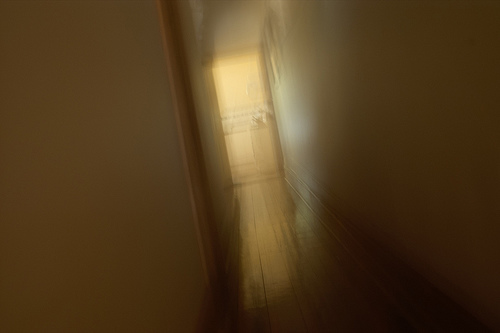Eric Scot Tryon
It was a Tuesday morning when the man stepped in front of the train that runs behind our house.
The train that runs behind our house. It’s dependable metallic chug has been the heartbeat of our home for nearly three decades. Every four hours, sunrise to sundown, everything shakes. Pictures aren’t falling from walls, but it’s enough to rattle your bones if you’re still. The track is a freight line out of San Pedro. No sleek passenger trains. Heavy trains. The kind of metal your grandfather knew.
Hannah and I weren’t home when the man stepped in front of the train that runs behind our house. But there was the back of our fence and top of our apple tree on the 10 o’clock news. There was the dusty wash, the riverbed rock and dry chaparral we traversed on sunset walks. And beyond the newscaster with perfect hair, there were the dozen little yellow flags, scattered about like confetti. Evidence flags. Markers for pieces to collect. Hannah had seen enough. She clicked off the TV and sat down to cry for the man who stepped in front of the train that runs behind our house.
Whatever I missed on the news, I heard from Doug across the street. He lived for neighborhood gossip. The man who stepped in front of the train that runs behind our house was ex-military. Two tours in Afghanistan. Doug said he was dressed in desert camo, head to toe in beiges and browns and lying so still on the ground not even the snakes knew he was there. Until the train approached. And he stood, and he stepped.
Doug had lived alone until moving his sick mother into the guest room several years ago. Caring for her 24/7 meant he rarely left the house and always knew everyone’s business: Carl Pendergrass bought a new Beamer he couldn’t afford. Ms. Carmichael chopped all her hair off. The police showed up to the Masons’ again. And it was Doug who had confirmed Hannah was having an affair. The red truck. The man with the beard.
A fully loaded freight train can weigh more than 6,000 tons and travel at 80 miles per hour. A fully loaded freight train can take up to 2 miles to stop. So even if the man who stepped in front of the train that runs behind our house had not been a still life in the sand, there was no stopping what was going to happen. I guess there’s something to be said for inertia and the laws about things in motion.
Doug said the man who stepped in front of the train that runs behind our house had left a note. Folded in half and placed under a rock near the tracks. All it said was that he held too many memories for one man to hold and kept too many secrets for one man to keep. Doug thought it poetic, but I thought it was just a real shitty thing to say for a man with a wife and daughter.
The train has become a trigger for Hannah. Every four hours. What used to rumble in the background, unnoticed, keeping our house from growing stagnant, now serves as a reminder. I watch her in the kitchen when she doesn’t think I’m looking. As the train screams unapologetic into our house, she grabs hold of the counter as if for balance, looks down and remains still. Is she thinking about the man who stepped in front of the train that runs behind our house? Is she thinking about me? Or the man with the red truck? And then the train passes, she wipes a tear and continues washing the dishes or chopping the onion.
I never told Hannah I knew about the affair. The red truck. The man with the beard. We had been married for thirty years, raised two children, buried three parents, survived one year of chemo. I guess there’s something to be said for inertia and the laws about things in motion. Instead, I let her lies camouflage among her truths to create the muted landscape of our lives. I figured I could hold on until it passed.
It was the Tuesday after the Tuesday that the man stepped in front of the train that runs behind our house. I was in the backyard picking aphids off tomato plants when I spotted something in the apple tree. A baseball cap. A camouflage of beige and brown. I needed a ladder to retrieve it. When I brought it into the house, it was less dramatic than I imagined. No blood, no name, no military numbers. Just a hat. I keep it in my closet, up high behind a box of old baseball cards.
A few days before the man stepped in front of the train that runs behind our house Doug told me he thought the affair was over. Hadn’t seen the red truck lately. The man with the beard. But he wasn’t entirely sure, and we both agreed it was much harder to prove the absence of a thing. Prove to me I’ve never been to Wisconsin.
Sometimes when I’m home alone I get the beige and brown hat out from behind the box of baseball cards and put it on. It fits a little too well. I sit at the kitchen table and wait for the train. I sit as still as can be, and I think about secrets—how many are too many for one marriage to hold? And then I think about inertia and the laws about things in motion. For every action there is an equal and opposite reaction. I wear the hat, and I sit as still as a ghost, waiting for the train to rumble by and rattle my bones. And even though I know the train is going east, I sit and wonder what direction we’re headed.
Eric Scot Tryon is a writer from San Francisco. His work was recently selected for the Best Microfiction 2023 anthology and has appeared or is forthcoming in Glimmer Train, Ninth Letter, Willow Springs, Wigleaf, Los Angeles Review, Sonora Review & elsewhere. Eric is also the Founding Editor of Flash Frog. Find more information at www.ericscottryon.com or on Twitter at @EricScotTryon.
Photo by Cory Woodward on Unsplash



